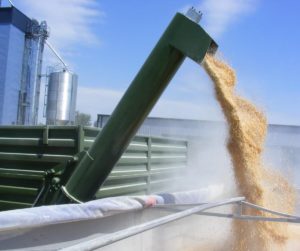
Ukraine as of July 4, 2019 threshed grain and leguminous crops on 2.5 million ha (25% of the forecast), harvesting 8.2 million tonnes of grain, the Agricultural Policy and Food Ministry has reported.
The ministry said that farmers harvested 4.85 million tonnes of winter wheat from 22% of the projected area, 2.6 million tonnes of barley from 75% of areas and 288,400 tonnes of peas from 56% of fields. In addition, farmers harvested 786,000 tonnes of winter rapeseeds from 30% of fields.
The ministry said that harvesting campaign was launched in 23 regions of Ukraine.
As reported, the ministry predicts an increase in the yield of grain in 2019 to 70.8 million tonnes with a gross harvest of grain in the 2018/19 agricultural year at the level of 70.1 million tonnes.
USDA projects grain harvest in Ukraine this year at 73 million tonnes, exports – at 51.2 million tonnes.

The share of public procurement of medicines in January-March 2019 totaled 20% of the Ukrainian pharmaceutical market, SMD consulting company (Kyiv) has said after studying the Ukrainian pharmaceutical market.
According to the company, in January-March 2019, budget medical procurement in monetary terms increased 40% compared to the same period of 2018 in the centralized procurement segment and by 19% in the procurement segment of medical institutions.
In addition, budget procurement in kind increased 134% in the segment of centralized procurement and by 13% in procurement by hospitals.
At the same time, the company said that in the first quarter of 2019, hospitals, in accordance with their needs, used the ending stocks of the 2018 budget funds to purchase drugs and expensive medicines.
In general, in the first quarter of 2019, the pharmaceutical market of Ukraine grew by 11% in monetary terms compared to the same period of 2018, to UAH 13 billion, while in kind it fell by 7%, to 177 million packages.
At the same time, according to the analysts of the company, the prescription segment in the first quarter of 2019 grew by 17% in monetary terms and decreased 1% in physical terms.
In addition, in the first quarter of 2019, sales of foreign manufacturers in kind decreased 5%, while sales of Ukrainian pharmaceutical manufacturers decreased 8%.

The group of companies Risoil S.A. in the 2018/19 agricultural year (July-June) increased grain handling by 19%, to 1.95 million tonnes, the company has said on its Facebook page.
Oil handling in the 2018/19 agri-year remained almost the same level as last year – 986,800 tonnes (990.4 million tonnes in the 2017/18 agri-year).
Risoil S.A. was established in Geneva (Switzerland) in 2000. Its core business is logistics of oil, bulk and general cargo in the ports of the Black Sea, sale and production of vegetable oils, trade in grain and oilseeds in containers, storage and processing of agro-industrial products.
Risoil Terminal in Chornomorsk seaport was launched in 2016.

PJSC Farmak pharmaceutical company (Kyiv) has introduced ex-president of Kyivstar Peter Chernyshov to the supervisory board of the company. Earlier Chernyshov headed Carlsberg in Ukraine.
“The supervisory board of Farmak made a decision to strengthen its membership by inviting a person with considerable experience in modern companies that have gone through intensive growth and development,” the company said, citing Head of the supervisory board and the final beneficiary of the company Filia Zhebrovska.
According to her, taking into account the work on the generics market, Farmak’s planning horizon is 5-10 years, so the company needs such specialists.
According to the release, the corresponding decision was approved by the Farmak shareholders at a meeting on July 4.
“I will work in the pharmaceutical industry. Of course, the most important thing is to understand how money is made in it and why some companies thrive and others do not. I will devote part of my time to Farmak, and I will even have a small office there,” Chernyshov said, commenting on his appointment in Facebook.
He said that membership in the Farmak’s supervisory board will not be his new permanent job. “I will not appear there every day and (most importantly) I will not lead anyone in the company. My main work will be participation in strategic projects of the company along with top management and other board members,” the ex-president of Kyivstar said.
According to him, one of the reasons why he agreed to this position is the desire to work with Zhebrovska, who invited him to talk about a new position about a month ago.
“My goal is to help achieve a further strategic goal – to increase our presence in the European market, while at the same time contributing to the development in Ukraine as a serious R&D center and a leading domestic producer,” Chernyshov said in the official press release.

The international reserves of Ukraine in June 2019, according to preliminary data, increased by 6.4%, to $20.639 billion in equivalent due to the placement of eurobonds by the government and the purchase of currency by the National Bank of Ukraine (NBU) in the interbank market, the NBU said on its website.

After having several nightmare experiences with Airbnb, my wife and I thought it would be good to know what it costs for a 5-star luxury hotel as a more reliable alternative to vacation rentals.
By doing this research we’d know our options and whether or not we could afford to stay at the best accommodation in any given destination to which we might be going.
We’ve created this resource to help you plan your next vacation and to show that it is possible to find affordable opulence if you go to the right place!

Our Methodology
To calculate the yearly and high season average price of 5-star hotels in each destination we used TripAdvisor as our primary data source. However, certain hotels and resorts didn’t have prices displayed, so in that case, we went directly to the hotel website.
We selected one weeknight in December, March, June, and September in 2018 and checked prices for the five best “Traveler Ranked” hotels in each destination and then averaged those prices to get the numbers you see in our dataset. By using this approach we were able to get a highly accurate representation of average hotel prices across the globe.
We had to expand the area of several destinations in order to have enough hotels in our dataset. These were mainly islands and small countries regions for example: Bali and Costa Rica. All research for each season was performed at least three months in advance to avoid prices being inflated due to last minute bookings. We ended up with 234 destinations around the world that you can browse in the below table.